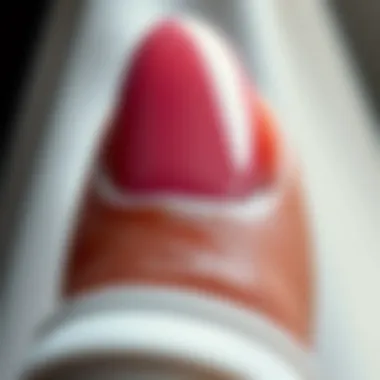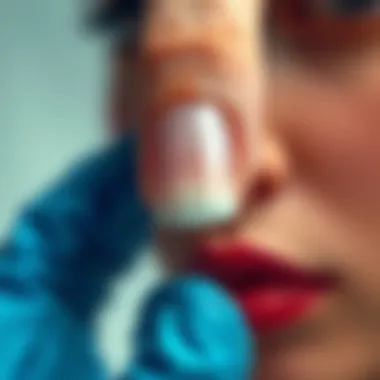Understanding the Nail Barrier: Structure and Care


Intro
Nail care often takes a backseat when one thinks of overall beauty and health. Yet, understanding the nail barrier—its anatomy, functions, and proper care—is vital for nail integrity. The nail barrier, composed of a complex interplay of biological materials, serves as the first line of defense against environmental aggressors. Just like a well-fitted garment enhances your appearance, a healthy nail barrier enhances the aesthetic appeal of your nails.
Importance goes beyond merely having a pretty set of nails; it affects health, confidence, and even day-to-day functionality. Comprehending this intricate topic will shed light on common ailments affecting nails, as well as effective strategies for maintenance and care. This guide aims to serve both fashion enthusiasts seeking style and health-conscious individuals eager to improve their nail health.
Whether you are gearing up for an important occasion or simply wish to maintain your everyday look, taking care of your nails can make a world of difference. Let's dive into the amazing world of the nail barrier, exploring how it works, its significance in our daily lives, and the best practices for care.
Preamble to the Nail Barrier
The nail barrier may not often be at the forefront of discussions about beauty or health, yet it plays a pivotal role in the context of both. An understanding of the nail barrier goes beyond mere aesthetics; it delves into the anatomy, function, and implications for overall nail health.
Defining the Nail Barrier
The nail barrier encompasses several anatomical components that contribute to both the functionality and aesthetics of nails. Primarily, it comprises the nail plate, cuticle, and the surrounding skin, which work in unison to protect the delicate structure of the nail matrix beneath. The nail plate, composed of hardened keratin, serves as the first line of defense against environmental hazards. Meanwhile, the cuticle acts as a seal, preventing contaminants from entering the nail bed and minimizing the risk of infection.
This barrier isn’t just about protection; it also plays a role in keeping nails hydrated and elastic. Healthy nails result from an intact nail barrier, which helps maintain their physical integrity and appearance.
Historical Context
Historically, nails have held significance across various cultures, serving not only functional needs but also as a canvas for expression. Ancient Egyptians, for instance, used pigment-rich substances to color their nails as a representation of status and beauty. Cultures throughout time have examined nail health, associating it with overall physical well-being. In the past century, advancements in dermatological research have elucidated the biological importance of the nail barrier, transforming our understanding of nail care.
From formal records in ancient texts to the rise of nail salons in modern society, the evolution of nail care reflects broader social changes. Today, it is no longer merely about style; it has evolved into a field that recognizes the intricate relationship between nail health and overall wellness. With this awareness comes the responsibility to address nail conditions effectively and embrace routines that preserve the health of the nail barrier.
“Understanding the nail barrier is not just for beauticians; it’s essential for anyone looking to maintain healthy and resilient nails.”
Through this exploration, we aim to fill in the gaps in common knowledge, providing insights that will resonate with fashion aficionados and professionals alike, emphasizing the intricacies involved in nail care. Empowering individuals with well-informed practices leads to a more aesthetically pleasing nail appearance and contributes to long-term nail health.
Anatomy of the Nail Barrier
Understanding the anatomy of the nail barrier is crucial, as it lays the groundwork for comprehending how nails function and what they require for optimum health. In this section we explore the distinct structures that make up the nail barrier, their respective roles, and how these elements collectively contribute to nail integrity.
Structure of the Nail Plate
The nail plate is the most visible part of the nail, yet many may not appreciate its multifaceted structure. It's a hard, protective surface primarily made up of a protein called keratin, which gives the nail its strength and durability. The composition of the nail plate varies in thickness based on genetic factors and even environmental conditions.
- Thickness and Appearance: Typically, fingernails are thinner than toenails, which often take on a tougher texture due to the heightened need for protection. The nail plate itself can exhibit various colors, and any changes might signal underlying health issues.
- Growth Rate: On average, fingernails grow about 3.5 millimeters per month while toenails grow more slowly. This differentiation in growth rates can lead to varied care routines tailored to each.
- Surface and Texture: The texture of the nail plate is generally smooth but can become uneven due to factors like aging or trauma. Regular maintenance can prevent many of these variances, aiding in the longevity of one’s manicures or pedicures.
Appreciating the makeup of the nail plate helps in recognizing how it interacts with our environment, especially with various nail products that might either promote or detract from nail health.
Role of the Cuticle
The cuticle acts as a physical barrier between the nail and the external environment, maintaining the integrity of the nail bed. Contrary to popular belief, it’s not just an aesthetic aspect of nail care but has significant functional importance as well.
- Barrier against Infection: The cuticle serves as a first line of defense against pathogens and contaminants that could potentially invade the nail bed. A well-maintained cuticle prevents bacteria and fungi from taking hold.
- Hydration: The cuticle aids in the retention of moisture in the nail bed and surrounding skin, which is essential for overall nail health. Neglecting it can lead to dryness and damage.
- Nail Growth: By protecting the nail matrix, the cuticle supports the natural growth cycle of the nail, allowing it to develop without issues stemming from dryness or irritation.
Therefore, regular care and attention to the cuticle area can vastly improve not just the health of the surrounding skin but also the quality of the nails themselves.


Nail Matrix Contributions
The nail matrix is perhaps the most critical element in nail development. Located beneath the cuticle, this area is where new nail cells are produced, forming the very foundation of the nail itself.
- Cell Production: The nail matrix is responsible for generating cells that harden and contribute to the growing nail plate. Any disruption in this process can result in various nail disorders.
- Color and Texture: Factors affecting the nail matrix, including trauma or health issues, can manifest visibly in the nail shape or color. Discoloration might indicate a problem, ranging from simple nail trauma to more severe systemic health issues.
- Age-Related Changes: As individuals age, the growth rate from the nail matrix may slow, leading to changes in appearance or texture. Being aware of these shifts can help in anticipating necessary adjustments to nail care.
Understanding the nail matrix is vital for recognizing how care routines impact nail growth and health. A thorough knowledge can lead to better practices, whether one engages in a professional setting or pursues personal nail care.
"The anatomy of the nail barrier is not just about appearance, but involves complex functions critical for nail health."
In summary, the anatomy of the nail barrier comprises interrelated structures, from the nail plate and cuticle to the nail matrix. Each element serves a unique purpose and works in concert to maintain the health, strength, and beauty of the nails. Knowing these components allows for enhanced care strategies that can ensure long-lasting nail health.
Functions of the Nail Barrier
The nail barrier serves as a crucial line of defense for the nails and the surrounding tissue. Understanding its functions is paramount for anyone interested in nail health and aesthetics. This section will delve into key elements that highlight the benefits of the nail barrier, examining how it operates to maintain the integrity of our nails while protecting them from various threats.
Protection Against External Damage
One of the primary roles of the nail barrier is to protect the delicate structures beneath the nail plate. Our nails are exposed to a myriad of external factors such as chemicals, physical trauma, and environmental extremes. For instance, think about someone who frequently works with cleaning agents or spends time in chlorinated water. Without a robust nail barrier, these exposures could lead to significant nail damage or even sloughing off.
The nail plate itself acts as a shield, absorbing impacts and resisting abrasions. The cuticle, often seen as a mere aesthetic line, actually plays a vital role by creating a seal that prevents dirt and potential pathogens from making their way into the nail matrix. This is incredibly important for individuals who engage in activities that put their hands at risk, such as gardening or construction work.
"The best defense is a good offense. In nail care, prevention is as crucial as treatment!"
Preventing Infection
Infections can wreak havoc on nail health, leading to pain, inflammation, and even long-term damage if not addressed properly. The nail barrier functions as a formidable defense against fungal and bacterial infections. The integrity of the cuticle is essential here; a damaged or neglected cuticle can allow microorganisms to infiltrate, setting the stage for conditions like onychomycosis, commonly known as a fungal nail infection.
Proper care of the nail barrier, therefore, becomes not just a beauty routine but a necessary step in health maintenance. Regular moisturizing and gentle cleaning help preserve the cuticle’s integrity. Using specific products that fortify the nail and cuticle can provide protective benefits that deter invaders. Knowledge about these preventive measures can greatly enhance one’s nail health.
Sensory Functions
The nail barrier isn’t just about protection; it also plays an active role in our sensory perception. Nails, through their wiring and structure, contribute to our sense of touch. Mechanoreceptors within the nail bed help transmit sensory information to our brain, allowing us to feel pressure, texture, and temperature through our fingertips.
Consider how many daily tasks depend on this sensory feedback—typing, texting, or even the gentle act of petting a furry friend. A compromised nail or damaged nail barrier could dull these sensations, making even the simplest activities feel awkward or uncomfortable. To maintain optimal sensory functions, paying attention to nail health is critical, as neglect or damage can lead to a lesser quality of life in terms of tactile experiences.
Common Nail Barrier Conditions
Understanding common nail barrier conditions is crucial for anyone keen on maintaining healthy nails. These conditions can affect not only the appearance of nails but also signal underlying health issues. By recognizing and addressing these conditions, one can significantly improve nail integrity and prevent more serious complications.
Nail Disorders Overview
Nail disorders encompass a wide array of conditions that can manifest in different ways. Some common examples include brittle nails, discoloration, and abnormal growth patterns. These abnormalities can stem from various causes, ranging from fungal infections to underlying health problems.
- Brittle Nails: Often prone to splitting and breaking, brittle nails can be the result of environmental factors or internal deficiencies. Lack of nutrients like biotin and calcium often contribute to this issue.
- Discoloration: Changes in nail color can indicate several health conditions. Yellow nails might suggest fungal infections, while white spots may be due to minor injuries or deficiencies in vitamins.
- Abnormal Growth: If nails grow slower than usual or suddenly start growing unusually fast, this may indicate an inconsistency in the body’s health or hormonal balance.
Thus, keeping an eye on these indicators becomes not just a matter of aesthetics but a focus on one’s overall health.
Fungal Infections and Their Impact


Fungal infections are among the most common issues affecting the nail barrier. Often characterized by discoloration, thickening, and brittleness, these infections can not only alter the nail's appearance but can also lead to significant discomfort. The impact of a fungal infection can go beyond personal grooming; it can prevent individuals from engaging fully in activities like swimming or sporting events.
- Transmission: Fungi thrive in warm, moist environments. Public places such as pools and gyms are prime spots for fungal growth, and getting infected is often easier than one might think.
- Symptoms: Common signs include a change in nail texture, color, and a foul smell that many find embarrassing to address.
- Treatments: Over-the-counter antifungal creams and oral medications can be effective. However, seeking professional help is essential, especially for persistent cases.
Investing in preventative measures, such as keeping nails dry and avoiding shared nail care tools, is equally crucial.
Psoriasis and Nail Health
Psoriasis is another condition that can severely impact nail health. This chronically inflammatory skin condition can manifest in the nails in various ways. It's a systemic disease often associated with a person’s joints and skin, underscoring its complexity.
- Nail Pitting: This refers to small depressions that form on the nail surface, leading to a rough texture.
- Onycholysis: This is when the nail separates from the nail bed, causing discomfort and potential complications.
- Discoloration: Nails may turn yellow or develop a brown tint, which can be distressing aesthetically.
Regular check-ups with a dermatologist can help manage this condition effectively. In addition, recognizing the link between emotional health and physical conditions is vital; how one feels can greatly influence the severity of symptoms.
Nail disorders are multifaceted but can be closely monitored through precise care and attention. By being proactive and informed, one can maintain the integrity and beauty of the nail barrier.
Nail Care and Maintenance
Nail care and maintenance play a vital role in preserving not just the aesthetics of one’s nails but also their overall health. Neglecting the nail barrier can lead to a myriad of issues, impacting the nail's appearance and functionality. With a properly cared-for nail barrier, individuals can enjoy beautiful nails, promoting confidence and style.
Daily Care Practices
Establishing a daily routine for nail care can be beneficial for both the nail barrier's integrity and the overall health of the nails. Simple practices, when done consistently, can vastly improve nail condition. Here are some effective daily care practices:
- Cleanliness: Gently wash hands and nails with soap and water. This removes dirt and bacteria that might compromise the integrity of the nail barrier.
- Moisturization: Apply a good quality hand cream or cuticle oil post-wash. This helps keep the nail and surrounding skin hydrated, reducing the chances of hangnails and nail brittleness.
- Gentle Grooming: Use a soft nail file to shape your nails instead of clipping them. Clipping can lead to jagged edges, while filing provides a smoother finish.
- Protection: Wear gloves while doing household chores or using harsh chemicals. This shields nails from damage and helps maintain their health, preventing common conditions.
Adopting these practices can significantly contribute to healthy-looking nails while also promoting the longevity of the nail barrier.
Importance of Hydration
Keeping nails and surrounding skin hydrated is often overlooked but is vital in preventing nail disorders. Dry nails can become brittle, leading to cracks and splits. Hydration aids the nail barrier by:
- Maintaining Flexibility: Adequate moisture allows nails to adapt to environmental changes, reducing the likelihood of breakage.
- Supporting Growth: Hydrated nails are less prone to problems, paving the way for healthy nail growth and better overall appearance.
- Enhancing Appearance: Well-hydrated nails have a natural shine and vitality. They appear healthier and more polished, enhancing your look effortlessly.
Incorporating water-rich foods and drinking plenty of fluids daily can complement external hydrating efforts, bolstering nail health from the inside out.
Nail Products to Consider
Selecting the right nail products is crucial for maintaining nail and nail barrier health. Here are some essential categories of products to consider:
- Moisturizers: Look for creams or oils containing ingredients like jojoba oil or vitamin E. These ingredients deeply nourish and hydrate the nails and skin.
- Base Coats: When applying nail polish, always use a base coat. It not only protects the nail barrier from staining but also helps in creating a thicker barrier.
- Nail Hardener: Products that strengthen the nails can be beneficial, especially for those with weak or brittle nails. Choose those free from harmful chemicals.
- Cuticle Removers: If you're inclined to push back cuticles, a gentle cuticle remover can make the process smoother.
Don’t forget to read the labels and opt for products that are free from harsh chemicals. This will ensure that you are not inadvertently causing damage to the fragile nail barrier.
Remember: The right products coupled with proper care practices can make all the difference for your nails.
Contemporary Insights into Nail Health


In today’s fast-paced world, understanding nail health goes beyond mere aesthetics; it becomes a gateway to both physical well-being and personal style. Nail care has evolved significantly, embracing scientific advancements and a holistic approach that emphasizes nutrition, technology, and mental health. These factors play a vital role in how we maintain our nails and achieve not just beauty, but health in our daily lives.
Advancements in Nail Technology
The speed at which nail technology has progressed is nothing short of remarkable. From traditional polishes to gel manicures, the options available today are vast and varied. Furthermore, innovations like dip powder and long-lasting formulas have reshaped how we view nail aesthetics.
- Smart Nail Devices: Recent developments have introduced smart technology to nail care. Devices that analyze nail health, polish quality, and even detect fungal infections are now emerging in the market. These gadgets make personalized advice readily available, potentially transforming how individuals approach their nail routines.
- Nail-friendly Formulations: Brands are increasingly prioritizing formulations that nourish rather than harm. Products infused with vitamins, proteins, and botanical extracts can enhance nail growth and strength, reducing concerns about damage from frequent applications.
- Sustainability: With environmental concerns taking the forefront, many companies are now focusing on sustainable practices. From eco-friendly packaging to vegan and cruelty-free formulations, modern nail products reflect a growing awareness of ethical consumption.
Nail Health and Nutrition
The link between nutrition and nail health is often overlooked, yet it’s fundamental for those wanting to achieve strong and beautiful nails. What goes into your body directly affects how your nails appear and function.
- Biotin: Often touted as the “nail vitamin,” biotin plays a crucial role in strengthening nails and promoting growth. Foods rich in biotin like eggs, almonds, and sweet potatoes are beneficial.
- Zinc: This mineral is essential for repairing cells and tissue; it can help prevent nail brittleness. Sources include meat, shellfish, legumes, and seeds.
- Hydration: Just as our skin craves moisture, so do our nails. Drinking adequate water ensures that nails remain hydrated from within, reducing the likelihood of splits and breakage.
It’s imperative to view nail care as a holistic process that encompasses proper nutrition, rather than a focus solely on topical products or treatments.
Psychological Aspects of Nail Care
Beyond the physical, nail care also carries significant psychological dimensions. The way we treat our nails reflects in our self-esteem and general mood.
- Self-Expression: Nail art and manicure choices can serve as forms of self-expression. The colors, patterns, and styles we choose often communicate our personality, style, and even mood to the world. This form of expression can enhance one’s confidence and personal brand.
- Therapeutic Rituals: The act of taking care of one’s nails can be therapeutic. Engaging in regular maintenance allows time for self-reflection and relaxation, fostering a sense of calm amidst the hustle of daily life.
- Social Implications: In professional and social settings, well-groomed nails can convey attention to detail and personal pride. This can impact perceptions and interpersonal interactions positively.
Ultimately, the modern dialogue around nail health illustrates how physical maintenance of our nails is intertwined with broader aspects of lifestyle and identity. This interconnectedness shapes how we perceive our nails and their role in our lives.
The insights derived from advancements in technology, nutritional impacts, and psychological factors underscore the importance of adopting a well-rounded approach to nail health. As the conversation grows, so too does our understanding of the complex weave that is nail care.
Finale: The Nail Barrier’s Significance
The nail barrier is more than just an aesthetic feature; it serves crucial roles in our health and daily wellbeing. Its significance goes beyond the surface, demanding attention not just from those who frequent nail salons, but also from anyone interested in personal care and health. As we have seen throughout this article, the nail barrier plays pivotal roles in protection, infection prevention, and sensory feedback. These factors are key to maintaining nails that are not only pleasing to the eye, but also strong and resilient against various external threats.
Being mindful of nail health contributes to overall physical health. Neglecting the nail barrier can lead to a slew of complications, including infections and a range of nail disorders. This means the importance of regular care and maintenance routines has never been more emphasized. With simple daily practices, one can significantly improve their nail barrier's integrity. Whether it’s routine moisturizing with nourishing oils or protective techniques during manicures, each detail counts.
Moreover, there’s a growing recognition of how our nails reflect broader health issues. Unusual changes in nail texture or color often hint at underlying medical conditions. By understanding what healthy nails should look like, individuals can be proactive rather than reactive about their overall well-being. Therefore, integrating the concept of nail care into one’s health regimen can yield more benefits than expected.
"Taking proper care of your nails is not just vanity – it's a vital part of self-care that can prevent potential health issues."
Recapping the Importance of Nail Care
Nail care should transcend beyond being a mere cosmetic endeavor. It’s essential to grasp how the various components of the nail barrier work in unison to maintain nail health. Regular practices such as gently pushing back cuticles, avoiding harsh chemicals, and keeping nails trimmed and neat, create a foundation for stronger nails.
Several key practices stand out as pivotal:
- Hydration: Proper hydration aids in mitigating brittleness, while helping to sustain the nail barrier’s function.
- Limit Exposure: Reducing exposure to damaging substances like detergents or solvents can significantly prevent wear and tear on the nails.
- Diet: Nutritional intake significantly affects nail health. Foods rich in biotin or zinc can enhance nail strength and appearance.
- Avoiding Bad Habits: Biting nails or picking at hangnails damages the nail barrier and invites infections.
Future Directions in Nail Health Research
As understanding of the nail barrier evolves, the future promises fascinating developments in nail health research. Current studies are increasingly looking at how genetics influence nail structure and health, aiming to identify hereditary nail conditions. Beyond genetics, research into perhaps the most exciting area: microbiome health of the nails, which explores how good bacteria contribute positively to nail integrity and prevent dryness or infections.
Moreover, advancements in technology have introduced new products that not only enhance aesthetics but also nourish the nail barrier. One such area lies in the development of polishes infused with vitamins and minerals that could bolster nail strength while providing the usual glamour.
Another forward-thinking approach is custom nail care regimens based on individual lifestyles and needs. Personalized products that consider a person's daily habits, environmental exposures, and dietary patterns could revolutionize how we approach nail care.
In summary, the significance of the nail barrier is multi-faceted. By grasping its functions, ensuring regular care, and acknowledging ongoing research, consumers can cultivate healthier nails that reflect both beauty and well-being.
For further reading on this topic, consider exploring resources like Wikipedia or Britannica. You can also check health forums like Reddit or public health sites like CDC for the latest discussions and findings in nail health research.







